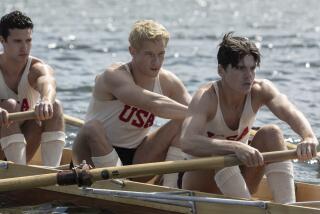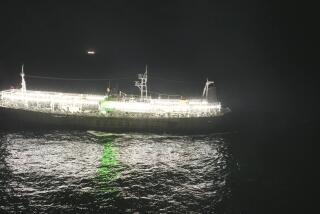Women Handle the Tough Calls in Crew
- Share via
SAN DIEGO — Megan O’Keefe described the anguish in their faces. The eight oarsmen faced her in a sailing vessel 62 feet long and 26 inches wide. She had just pushed her crew to the brink. Maybe she pushed them over edge.
“Different people have different expressions,” O’Keefe recalled of her days as a coxswain on the UC San Diego men’s novice 8. “They look like someone is pulling their limbs off. Some look like they’re going to cry. There were times when I couldn’t look my strokes in the face. I had to look right past them because it looked like they hurt so bad. And I felt bad because I was asking them to do more when all I was doing was sitting on my butt.”
O’Keefe was a woman in a man’s world. But she was not alone.
Female coxswains directing the men’s eight-man shells are not unusual in crew. That should be apparent today and Sunday on Mission Bay when 49 colleges and 40 clubs gather for the 18th annual San Diego Crew Classic.
“Parents get a kick out of it,” said Mike Shannon, UCSD men’s coach. “Especially the moms. They see these 6-foot-4 guys and this little tiny coxswain telling them what to do. There’s not very many chances in life where a little person tells a big athlete-type to stand on their head and they do it, especially when it’s a female and a group of college males.”
UCSD women’s Coach Jack Vallerga estimated that on the West Coast, 60 to 70% of the coxswains in the men’s divisions are women. Size is a major consideration. The minimum weight requirement for a coxswain in the men’s shells is 125 pounds. Anyone less than 125 must bring along weights to compensate. Anyone heavier than 125 simply adds unnecessary weight. At the collegiate level, there just aren’t enough 125-pound male athletes to go around.
That opens the door for women, who still must overcome obstacles they might face outside of college.
“If she’s an engineer at General Dynamics and she has to get a bunch of men to acknowledge her authority and get them to work as a team, she can’t waste time fending off advances or being treated like she’s someone’s daughter or niece,” said Vallerga, a former coxswain at UC Santa Barbara.
“In crew, all the same pressures are there. You have big men, athletes, who are having to take instruction from a diminutive female their own age. This is not to say it works well straight across into the business world, but if she can get through that, she’s got a pretty good idea of how to work her way past the stereotypes that are going to be present in a law firm. Her leadership, her ability to handle (her own) authority, the artfulness of earning respect, that’s a lot of what being a female cox on a men’s team is like.”
The relationship between the coxswain and the crew is special. She must know the different personalities and how to motivate them. And in getting to know those personalities, there are times when relationships go beyond that of being teammates. That is frowned upon by coaches.
Junior Annette Branger is the coxswain for UCSD’s varsity 8. She dated one of her crew briefly in her first season three years ago.
“It was very short and very abrupt,” she said. “I was new (to the program) and quickly put in my place (by Shannon). It’s not a good idea. Instead of having a relationship that’s equal, one relationship becomes more important than the other seven. It would ruin the balance. . . . I look at them as eight big brothers.”
Last year, Dana Cohen coxed the UCSD varsity to its first City Championship. She was dating oarsman John Burke, who is currently in his fourth year.
“As long as you can separate crew and your relationship, it’s OK,” Burke said. “I was able to do that. It has its good and bad sides. One year, the novice crew all liked their coxswain and the guys started disliking each other.”
Not exactly the right attitude when perfect harmony in the water is required.
For Branger, there’s a fine line. Be a friend of the crew, but not too friendly. She establishes a professional distance.
“I can’t hang out with them the way they hang out with the rest of the crew,” she said. “They have to have a respect for the position. If they lose that respect, they won’t obey your orders. If you’re just an authority figure, you can’t ask them to push themselves and at that point, you become the enemy. But when you’re a friend and you know them, you can ask more of them.”
And coxswains ask for every ounce of energy. Throughout the season they must be part slave-driver, part Norman Schwartzkopf.
“At full pressure, racing against another crew, the cox’s goal is to have the whole crew horizontal at the finish--where the tank’s empty--to get the boat to go its fastest,” Shannon said. “The cox’s first job is steering, but she also implements the race plan, notes the position in relation to the other boats and follows the strategy to get them in proper position.”
And the coxswain, ultimately, is the reason for those anguished faces.
“The oarsmen have to be masochists, the coxswain has to be a sadist,” Shannon said.
Branger understands the role.
“Most people never test their threshold of pain,” she said. “Sometimes it’s an odd feeling. You (as coxswain) haven’t put out any physical exercise and you have eight people in front of you who are dead, and you can’t forget that you’re a big part of the reason they’re there.
“They can’t function without you and you can’t function without them. Your job is not the same, but it’s just as important.”
“It’s sort of an unappreciated role,” oarsman Dave Berry said. “The rowers get all the glory and the coxswain is in the background.”
Vallerga says it is difficult to see the crew work.
“The cox has to sit there and watch her crew commit athletic suicide, has to see the pain,” he said. “In crew, the better you get at it, the more you hurt. The cox is sitting there staring at it. You know what the person is going through. (But) the cox can’t yield to the temptation to end the suffering. In a workout, even if you know they’re hurting, the cox has to look through it (to) make the effort they’re going through worthwhile.”
O’Keefe has been on both ends. After coxing her first season, she made the transition to oarswoman and now is on the junior varsity. She remembered her first time in the boat.
“I was terrified,” she said. “(Shannon) got us off the shore. I thought he was going to stand on the shore and tell us what to do. I’m there with eight guys looking at me wondering what to do. They don’t do anything until you tell them what to do. It’s kind of bizarre.
“At the end of the year, I felt like I was getting almost mechanical. After a hard workout early in the year, I felt so bad (for them). At the end of the year, I would forget that there were people on the end of those oars and those people were getting tired and irritable. But to get good results, the coxswain has to look beyond what you think is their threshold of pain.”
The theory is that coxswains can’t win a race but can lose it. How comforting that must be for the coxswains who steer the shells along the 2,000-meter Mission Bay course where wind and 90-degree tidal currents test a coxswain’s mettle and skill.
“Coxswains that are worth it are compulsive worriers about the people and the equipment in front of them,” Vallerga said.
The pressure is the toughest part of the position.
“The constant responsibility, where everything is on my shoulders, is the most difficult thing,” Branger said. “If something goes wrong, it’s on my shoulders. It’s always your problem. Given any situation, you have to have a clear head and stay calm because you’re the one everyone looks to.
“You can’t blame it on the oarsmen because they row and that’s their job. Your job is to make sure everything else is running smoothly.”
If not painfully.
CREW CLASSIC WEEKEND
What--The 18th annual San Diego Crew Classic takes place with 77 races over two days. The field consists of 49 colleges and 40 rowing clubs with more than 2,400 rowers. The 2,000-meter course on Mission Bay ends at Crown Point Shores.
When--Today and Sunday.
Time--Women’s World Cup heat races begin at 6:45 a.m. today and the men’s World Cup heats follow at 7:25 a.m. College racing begins at 8 a.m. and club racing begins at 12:40 p.m. and continues through 4 p.m. On Sunday, Whittier Cup qualifying begins at 7 a.m. World Cup races begin at 8:55 a.m. The Women’s California Cup is 10 a.m., the Men’s California Cup is 10:25 a.m. The Whittier Cup is at 1:40 p.m., the Copley Cup at 2 p.m. Sunday
More to Read
Get our high school sports newsletter
Prep Rally is devoted to the SoCal high school sports experience, bringing you scores, stories and a behind-the-scenes look at what makes prep sports so popular.
You may occasionally receive promotional content from the Los Angeles Times.






